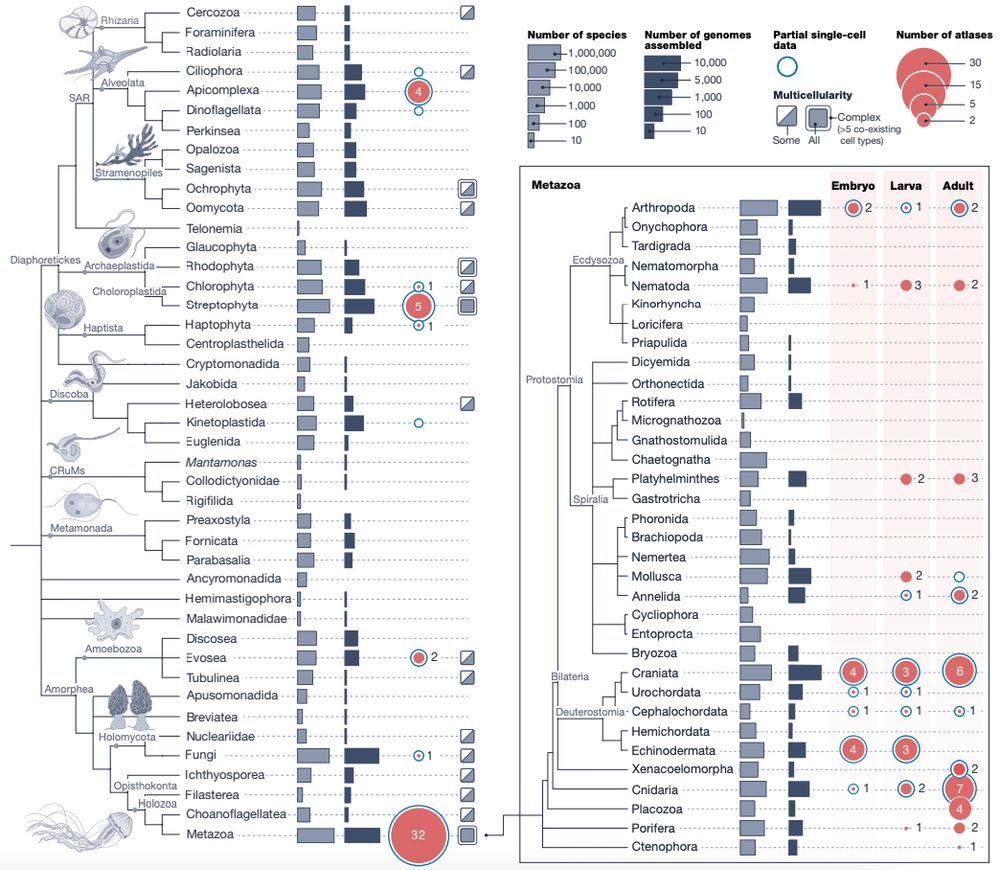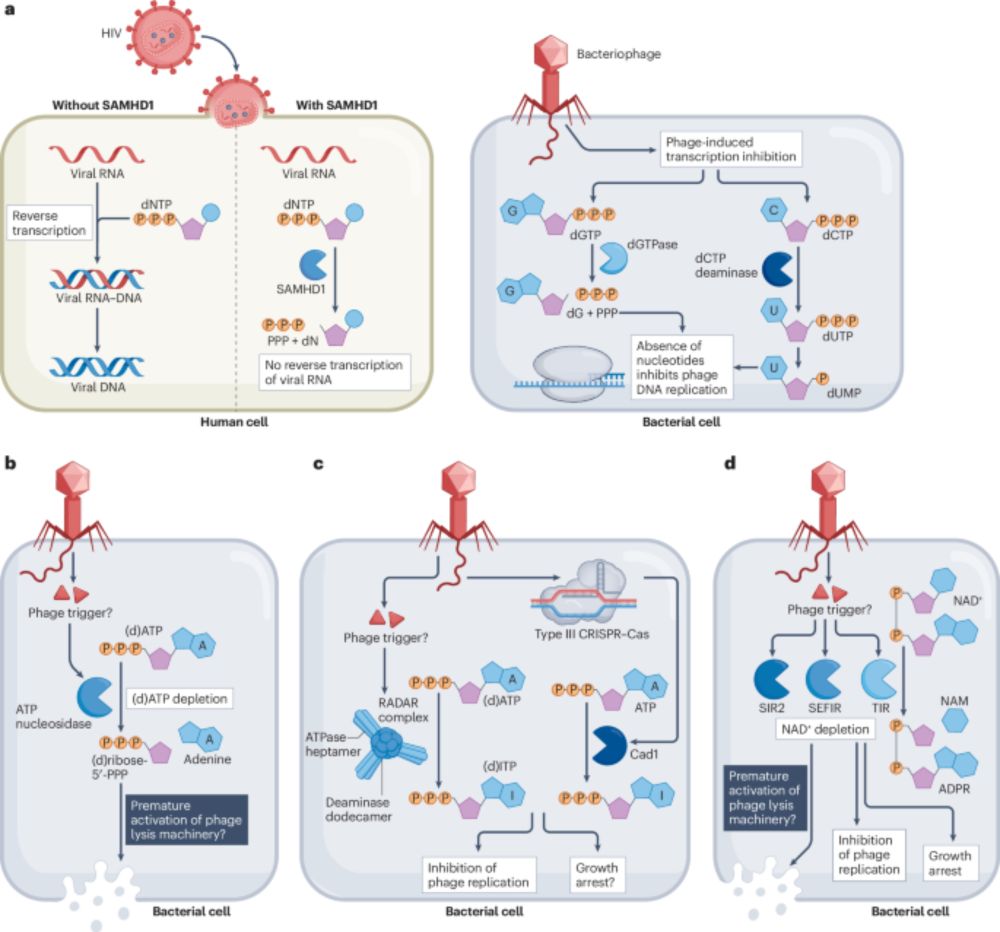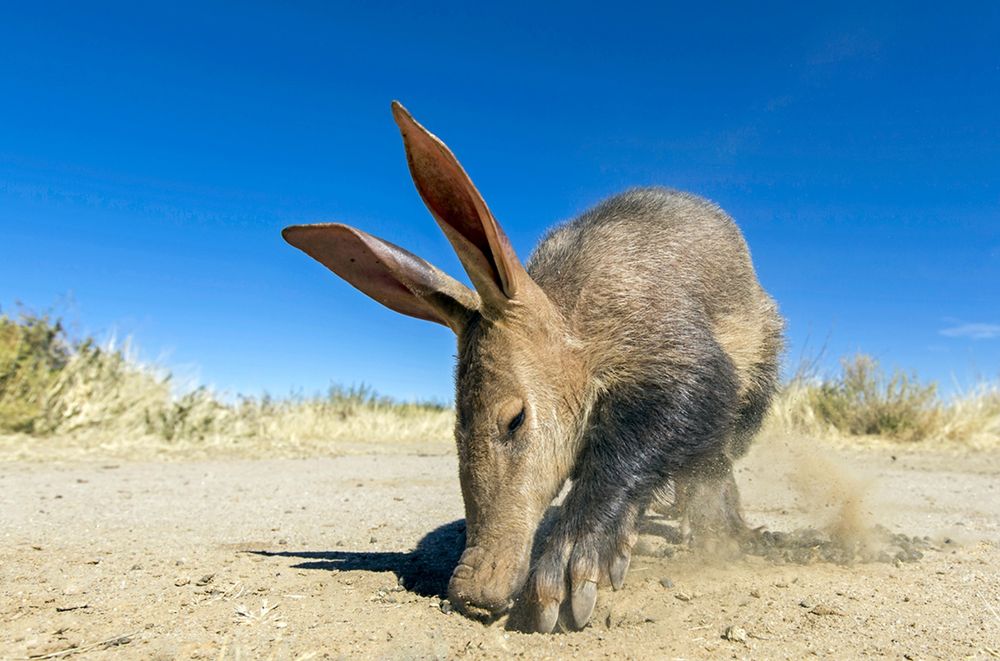
A miniature CRISPR–Cas10 enzyme confers immunity by inhibitory signalling - Nature
Panoptes, an anti-phage defence system against virus-mediated immune suppression, is revealed.
Now online at @nature.com we show how the Panoptes defense system protects against viruses that attempt immune evasion - and expands our understanding of the role of oligonucleotides in immunity.
Check out this work co-led with @benadler.bsky.social here:
www.nature.com/articles/s41...
02.10.2025 03:01 — 👍 49 🔁 21 💬 2 📌 2

Our October issue is out now!
The images are negatively stained electron micrographs taken from archaella bundles isolated from the archaeon Sulfolobus acidocaldarius.
Check the issue out here:
www.nature.com/nmicrobiol/v...
01.10.2025 21:25 — 👍 20 🔁 6 💬 1 📌 0

Who fixes carbon in the dark ocean?
A new study led by Barbara Bayer (CeMESS, University of Vienna) discovered that ammonia-oxidizing microorganisms contribute much less to carbon fixation in the ocean than previously assumed. The study...
Who fixes carbon in the dark ocean? A new study in @nature.com, led by @barbarabayer.bsky.social @univie.ac.at shows that ammonia‐oxidizing microbes contribute much less to dark carbon fixation than previously thought – leaving room for unknown players.
Read more: 🔗 dome.univie.ac.at/news-events/...
23.09.2025 09:47 — 👍 15 🔁 10 💬 0 📌 1

Happy to share the Biodiversity Cell Atlas white paper, out today in @nature.com. We look at the possibilities, challenges, and potential impacts of molecularly mapping cells across the tree of life.
www.nature.com/articles/s41...
24.09.2025 15:12 — 👍 215 🔁 104 💬 2 📌 10

Phages with a broad host range are common across ecosystems - Nature Microbiology
Proximity-ligation-based sequencing from 111 samples and 5 environments reveals that a substantial proportion of phages infect multiple species.
You like phages ? In this publication, we use metaHiC and our new version of the MetaTOR pipeline to challenge the traditional view of phages with a narrow host range.
@rkoszul.bsky.social @natmicrobiol.nature.com @cnrs.fr @institutpasteur.bsky.social
www.nature.com/articles/s41...
19.09.2025 09:32 — 👍 78 🔁 36 💬 6 📌 3

The largest study on late life virginity, based on >400k individuals, out now in @pnas.org
Open access link: pnas.org/doi/10.1073/...
Shoutout to shared first author @laurawesseldijk.bsky.social ❤️
Thread below 👇🏽
16.09.2025 20:25 — 👍 23 🔁 6 💬 2 📌 0
🦠➡️🧬 Community context matters!
In the second part of my PhD, we show how microbial complexity drives phage–bacteria ecology & evolution.
Check out the preprint 👇🏼
11.09.2025 05:18 — 👍 8 🔁 4 💬 1 📌 2

Looking for a new approach to studying or eliminating phages? Check out our study introducing anti-phage ASOs (antisense oligos) out in @Nature today. nature.com/articles/s4158…
10.09.2025 15:40 — 👍 129 🔁 63 💬 4 📌 2

Pasteur-Paris University International Doctoral Programme, The call for enrollment of students in October 2026 will be open from September 1st to October 20th, 2025
🎓 Applications for Institut Pasteur's PhD programs open Sept 1-Oct 20, 2025 for October 2026 entry.
Apply to up to 4 projects across 6 programs: PPU, PPU-IMAGINE @institutimagine.bsky.social, PPU-@ox.ac.uk, PPU-EID @upcite.bsky.social & more 🧬
Register now ✍️ www.pasteur.fr/en/education...
01.09.2025 09:44 — 👍 33 🔁 34 💬 0 📌 6
New research: With ancient origins & surprising flexibility, #BrownAlgae reveal a compelling story of sex chromosome evolution. This could rewrite how we view sex determination. Learn more: s.gwdg.de/YDoZ3L
Congrats to @agalip.bsky.social & Josue Barrera for their work in @natecoevo.nature.com
27.08.2025 12:25 — 👍 30 🔁 10 💬 0 📌 1
🚨 Imagine a bacterium that refuses to follow the textbook:
It grows as tangled filaments, divides unevenly, reshapes its own membranes… and even builds grappling hooks.
Meet Litorilinea aerophila — and here’s why it blew our minds.
20.08.2025 10:34 — 👍 165 🔁 70 💬 5 📌 5

Left: Results of spotting various supernatants onto lawns of Halalkalibacterium halodurans, Phycicoccus endophyticus, and Virgibacillus salexigens. a,b: top fraction (>3 kDa) of supernatant from Haloferax volcanii expressing an intact (a) or catalytic mutant (b) version of Woldo; c,d: bottom fraction (<3 kDa) of supernatant from H. volcanii expressing an intact (c) or catalytic mutant (d) version of Woldo; e: unfiltered supernatant from Halogranum salarium B-1; f,g: top fraction (>3 kDa) of supernatant from H. volcanii expressing (f) Danwoldo or (g) and empty plasmid control; h,i: bottom fraction (<3 kDa) of supernatant from H. volcanii expressing (h) Danwoldo or (i) and empty plasmid control. Top right: Structural overlay of zoocin A from Streptococcus zooepidemicus (UniProt ID: O54308) and Woldo, a candidate PGH from Halogranum salarium B-1 (UniProt ID: J2ZZK6), highlighting homologous M23 domains but divergent cell wall binding domains. TRD: target recognition domain. PG: peptidoglycan. Bottom right: Images of bacterial cells following exposure to H. volcanii supernatants expressing Woldo, Danwoldo or the control (as above). Bacteria are stained using LIVE/DEAD BacLight bacterial viability staining kit with ingress of red dye into bacterial cells indicative of cells with terminally compromised cell wall integrity.
Archaea-on-bacteria action! @romainstrock.bsky.social @tobiaswarnecke.bsky.social &co show that many #archaea encode #peptidoglycan hydrolases, which specifically target #bacterial cell walls, experimentally confirming the killing capacity of 2 of these enzymes @plosbiology.org 🧪 plos.io/4lrJBBa
15.08.2025 08:13 — 👍 16 🔁 8 💬 1 📌 1

Deep learning reveals antibiotics in the archaeal proteome - Nature Microbiology
Use of artificial intelligence to mine proteomes of archaea led to the discovery of archaeasins, antimicrobials that kill drug-resistant bacteria in laboratory and animal models, offering a promising ...
(1/5)For over a century, the hunt for new antibiotics has focused almost exclusively on bacteria and fungi. Today, that paradigm shifts. By coupling state-of-the-art AI with the vast, largely uncharted diversity of Archaea, we open a new frontier for molecular discovery.
12.08.2025 11:10 — 👍 53 🔁 23 💬 1 📌 0

Manipulation of the nucleotide pool in human, bacterial and plant immunity - Nature Reviews Immunology
Modification of the nucleotide pool is emerging as key to innate immunity in animals, plants and bacteria. This Review explains how immune pathways conserved from bacteria to humans manipulate the nuc...
NEW Review from @soreklab.bsky.social @dinahoch.bsky.social explains how immune pathways manipulate the availability of nucleotides, chemically modify nucleotides to generate immune signalling molecules, and produce altered nucleotides that poison viral replication
#immunosky #microsky #phagesky
29.07.2025 14:52 — 👍 29 🔁 14 💬 0 📌 0

‘Things keep evolving into anteaters.’ Odd animals arose at least 12 separate times
Findings speak to the dramatic impact ants and termites can have on mammalian evolution
Crab-like creatures are famed for having evolved five times in evolutionary history. But anteaters have evolved at least 12 times--in half the evolutionary span. Cool story by @jakebuehler.bsky.social for @science.org
28.07.2025 15:54 — 👍 828 🔁 291 💬 25 📌 74
🦠🧍♀️From bacterial to human immunity.
We report in @science.org the discovery of a human homolog of SIR2 antiphage proteins that participates in the TLR pathway of animal innate immunity.
Co-led wt @enzopoirier.bsky.social by D. Bonhomme and @hugovaysset.bsky.social
www.science.org/doi/10.1126/...
24.07.2025 18:22 — 👍 262 🔁 122 💬 9 📌 11
My first first-authored paper is now out ahead of print in #mBio. It was a loooong way between journals, but here we are with a result that I believe will be highly relevant for anyone interested in microbiology and evolution! 🦠🧬
👇
journals.asm.org/doi/10.1128/...
24.07.2025 09:09 — 👍 7 🔁 2 💬 2 📌 0
And the story is published now!🍾
www.nature.com/articles/s41...
Open access link: rdcu.be/exnOc
Many years in the making, great collaboration with @archaellum.bsky.social & @tunglejic.bsky.social
Thanks @ukri.org BBSRC & @leverhulme.ac.uk for funding, reviewers & editor!! 🙏
#microsky #archaeasky
22.07.2025 21:06 — 👍 84 🔁 33 💬 4 📌 0

Transcription gets more noisy and co-expression more heterogeneous when S. islandicus cells age (in G2)
#aging #archaea #transcriptomes #networks
Thanks to Miguel Gomez Raya Vilanova :) and all great co-authors: Annette Baudisch, Claudio Franceschi, Yuping Dai, @jerometeu.bsky.social
07.07.2025 18:19 — 👍 2 🔁 1 💬 1 📌 0
#ArchaeaSky
#MicroSky
07.07.2025 18:20 — 👍 6 🔁 4 💬 1 📌 0
Thanks, Alex!!
01.07.2025 20:27 — 👍 0 🔁 0 💬 0 📌 0
Thanks to @danielabarilla.bsky.social and the other reviewers for their comments and suggestions, it is now a much more complete and exciting piece of research!
01.07.2025 13:01 — 👍 2 🔁 0 💬 1 📌 0
Elated to have our pre-print now published in @natcomms.nature.com #ArchaeaSky #Microbiology #MEvoSky
rdcu.be/euila
Our main results stay the same: S. islandicus follows a cell cycle akin to that of some eukaryotes, like the budding yeast, with cellular processes cycling similarly.
old🧵cited below👇
01.07.2025 13:01 — 👍 30 🔁 17 💬 1 📌 0

Enrichment cultivation and visualization of Ca. Methanonezhaarchaeum fastidiosum
Preprint🚨 #microsky 🦠 “Cultivation of Methanonezhaarchaeia, the third class of methanogens within the phylum Thermoproteota”, authored by @kohtzarchaeota.bsky.social & Sylvia Nupp, expands the diversity of methanogens! 90% enriched, methylotrophic culture from a hot spring. A 🧵 tinyurl.com/yw8ku2bj
26.06.2025 04:44 — 👍 50 🔁 21 💬 1 📌 1
Structural Bioinformatics👨💻🧬
PhD student at Atkinson Lab, Lund University
Drosophila germline with JR Huynh and choanoflagellates bridges with T Brunet.
Laboratoire d'Optique et Biosciences / Laboratory for Optics and Biosciences
unité @cnrs.bsky.social @Inserm @Polytechnique
https://lob.ip-paris.fr/
Graduate Student @UW |
Microbial Ecophysiology (Nitrification & Methanogenesis) |
Surf, hike, concerts, read
Centre for Microbiology and Environmental Systems Science at @univie.ac.at, pioneering microbiome and environmental research for the benefit of the planet.
Aquatic microbial ecology and biogeochemistry
Assistant Professor @cemess_vienna
Phage Biology, Bacterial defense systems, CRISPR-Cas, Microbial communities, Mucus interactions
http://www.fnobregalab.org
http://www.klebphacol.org
http://www.phage-collection.org
Organizations, structures and dynamics of microbial communities. Phages lover. CNRS researcher. Developer of HiC technics and bioinformatic pipelines applied to metagenomes. Opinions are my own.
Reappraising the role of whole genome duplication and rediploidisation in eukaryotic evolution.
Funded by BBSRC Strategic Longer and Larger scheme.
Check out our website for information about the project, team and more!
https://www.rediploidisation.org/
Biologist at the Stowers Institute studying cnidarian development, evolution and symbiosis.
Our team is studying bacteriophages that are viruses infecting bacteria. Since 2006, Laurent Debarbieux has reignited a research lab about phage therapy following the pionnering work of Félix d'Herelle started in early 20th century.
🔬 Assistant Prof, Pathology @Duke | Director, Clin Micro Lab
🧫 Former Clin Micro Fellow @Memorial Sloan Kettering
👩🏻🔬 Former Postdoc @broadinstitute.org
🎓 PhD @The Rockefeller University
Focus: Diagnostics, AMR, Structural Biology
Postdoc in evolution of microbes. I study protists losing mitochondria, algae stealing plastids, and bacteria living on nothing but sulfur. IUEM, Plouzané, BZH, FR. https://lukasnovak.eu/ https://scholar.social/@animalculum he/him
Protists, microscopy, biophysics, evolution. Interested in how cells control shape and movement https://www.benlarson.org
Natura in minimis maxima
Asst Prof, RPI | Postdoc, UCSF, Wallace Marshall | PhD, UCBerkeley, Nicole King | BA, Physics, Reed College
Signaling and Asymmetry of the Bacterial cell lab at MMSB - CNRS Lyon
MRC CDA Fellow at Imperial College London | Genotype-phenotype maps, fitness landscapes, Group A Strep, AMR | A #firstgen still learning to navigate the academic landscape
symbiosis, tree of life, biodiversity
PhD candidate @anja1.bsky.social group @NIOZ and @UvA 🇳🇱. Interested in molecular evolution, Archaea and cell biology. https://w-huang.com
Microbiology Society: A world in which the science of #microbiology provides maximum benefit to society | microbiologysociety.org
lnk.bio/microbiosoc


















